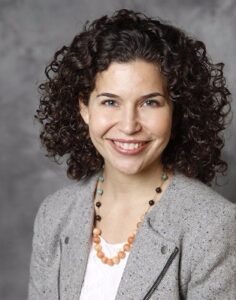 IFF’s profile this month is on Janis Bowdler, Head of Community Development, Small Business, and Financial Capability Initiatives, Global Philanthropy at JPMorgan Chase.
IFF’s profile this month is on Janis Bowdler, Head of Community Development, Small Business, and Financial Capability Initiatives, Global Philanthropy at JPMorgan Chase.
What is your current role at JPMorgan Chase?
I am the Head of Community Development, Small Business, and Financial Capability Initiatives, Global Philanthropy, JPMorgan Chase. Under my leadership, the firm invests more than $80 million each year to advance strategies that connect distressed communities and underserved individuals and entrepreneurs from around the world with the tools, resources, and opportunities necessary to prosper. Since I joined the firm in 2013, we have launched several high-profile initiatives, including Financial Solutions Lab, PRO Neighborhoods, National African American Loan Fund, and blight mitigation initiatives in Detroit, MI.
Tell us more about JPMorgan Chase’s PRO Neighborhoods initiative. Why this approach?
Over the last decade, many cities have seen their downtowns or commercial corridors make a big comeback – something that seemed unlikely the decade prior. But that economic resurgence still hasn’t reached many of the most distressed neighborhoods, and, when it does come, the growth threatens to displace long-time residents. PRO Neighborhoods provides the capital necessary to local community development financial institutions (CDFIs) to address the drivers of economic opportunity in neighborhoods. These CDFIs work together to pool resources and expand lending activities to build health and education facilities, open retail centers, and support community services in area neighborhoods.
What have been the results so far? Can you share a success story or two?
According to an impact assessment by The Harvard Joint Center on Housing Studies, JPMorgan Chase’s 2014, $33 million PRO Neighborhoods pilot program focused on disadvantaged neighborhoods allowed 26 CDFIs to raise more than $339 million in additional capital for local economic and social service projects. This has resulted in $270 million in loans, financing first-time home purchases, preservation and development of 1,975 units of affordable housing, lending to 331 small businesses, and creating and retaining 4,432 jobs.
JPMorgan Chase also has made a big commitment to help turnaround the city of Detroit. Can you tell us more about that?
Two years in to JPMorgan Chase’s $100 million commitment to Detroit, we continue to focus on fueling Detroit’s comeback. Our most recently announced initiatives include $4 million for preserving affordable housing in neighborhoods, $1.5 million to strengthen job training and summer youth employment, and other efforts to support small business growth. Our financing has already supported $240 million in local community development projects, allowed hundreds of Detroiters to receive job training, and provided $1.3 million in loans to minority-owned small businesses. We are incredibly proud of our partnership with Mayor Duggan and the progress we’ve seen so far.
Prior to joining JPMorgan Chase, you worked at National Council of La Raza (NCLR) for many years. How does your past experience working for the nation’s largest Latino civil rights and advocacy group inform your current work?
During my 10 years at NCLR, I had the opportunity to advance policy and practice that allowed Latino families to build assets, purchase their first home, avoid foreclosure during the recession, and bank and borrow more securely. I quickly learned that the best ideas and most promising solutions often came from NCLR’s 300 affiliates that worked with our community daily. My role was to provide the families and practitioners with a united voice on Capitol Hill. I take this lesson with me as a funder. Top-down solutions often run into trouble if they are not rooted in local context. If we are going to truly advance economic mobility in distressed neighborhoods, the voices, experiences, and aspirations of local residents must serve as the foundation for any approach.
It’s a new year. What’s your shortlist of major challenges and opportunities for CDFIs in 2017?
While the community finance field is several decades old, we have barely scratched the surface of what CDFIs can accomplish. CDFIs such as IFF and others are becoming more sophisticated in how they access and distribute capital – but, at the same, time there is so much more we can do! This year I’m thinking about three challenging opportunities:
- How can we leverage the collective capacity of CDFIs to further increase sophistication, tap new capital markets, and drive capital to the communities that need it the most?
- Scale and sophistication is great – when you have it, but, in fact, CDFI coverage is uneven around the country. How can we build the balance sheets and skills of smaller CDFIs, allowing them to become capital engines in their neighborhoods?
- CDFI leadership is not nearly as diverse as their missions might suggest or require. We’re looking for ways we can help CDFIs build a diverse bench and strengthen support for diverse led organizations.
We work with hundreds of CDFIs across the country, and I humbled daily by what they are able to accomplish. I consider it a privilege to partner with you all on our shared goal of creating greater equity and economic inclusion in our cities and neighborhoods.
You’re originally from Ohio, where IFF expanded to a couple of years ago and where we opened a new office in 2016. Any advice for us on how to best serve your home state?
Wear scarlet and learn Hang On Sloopy.